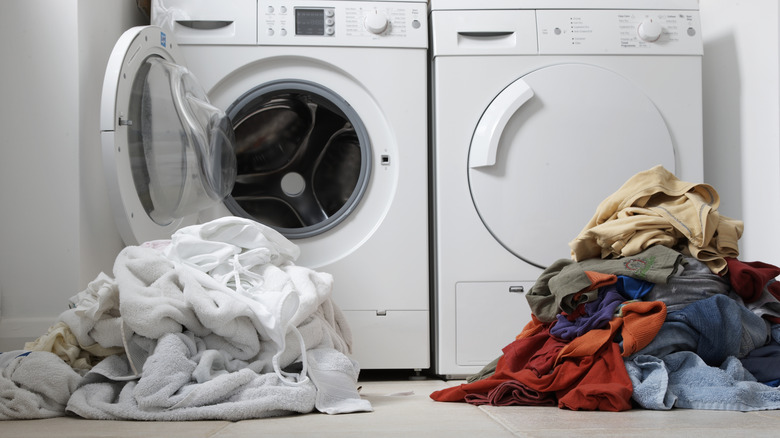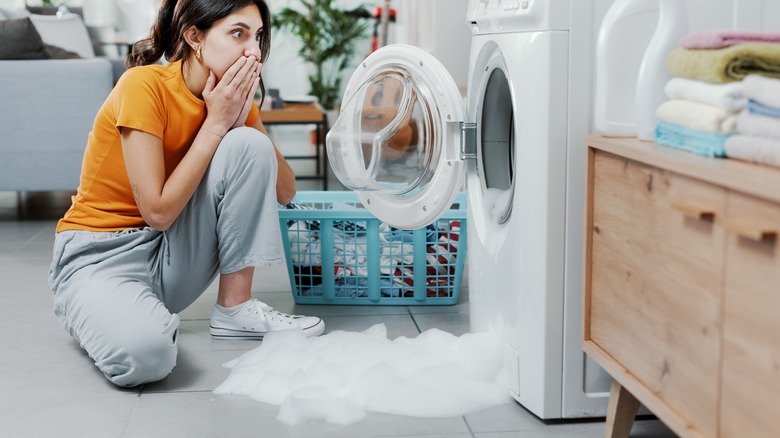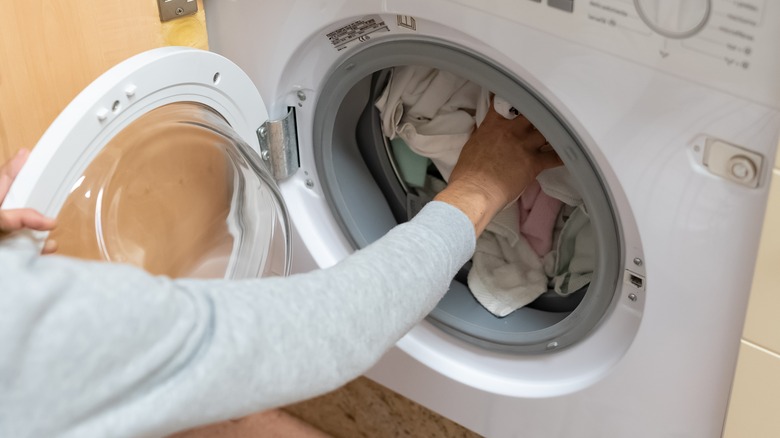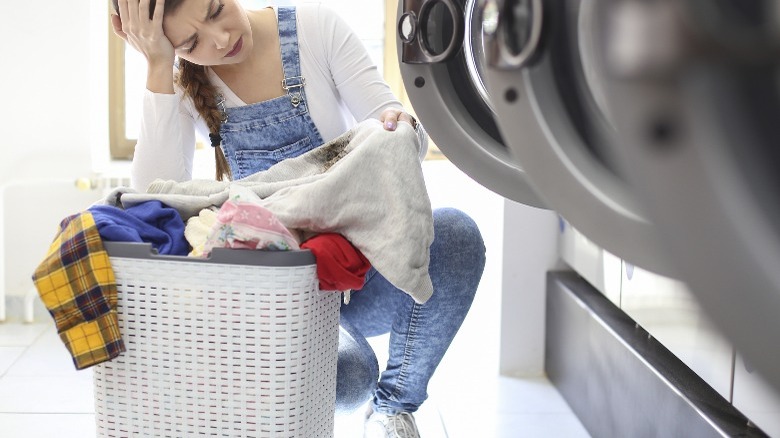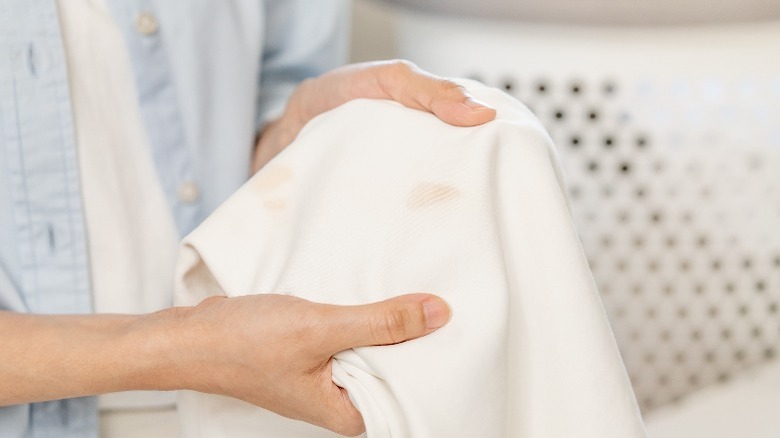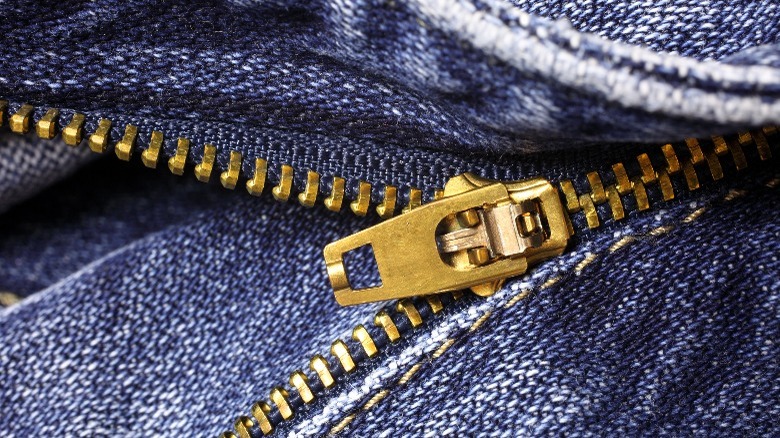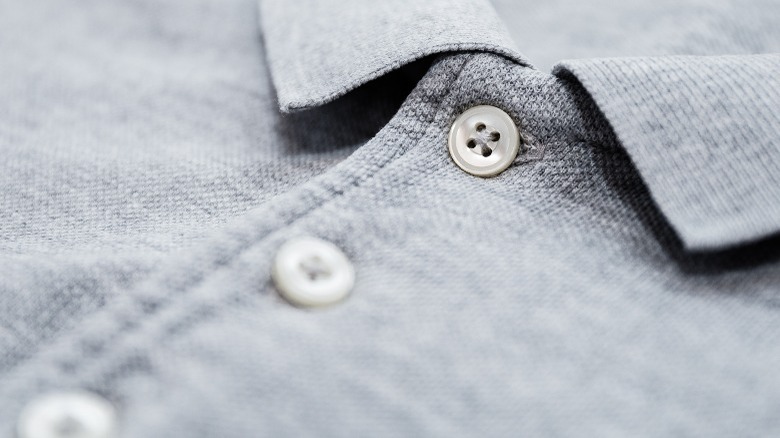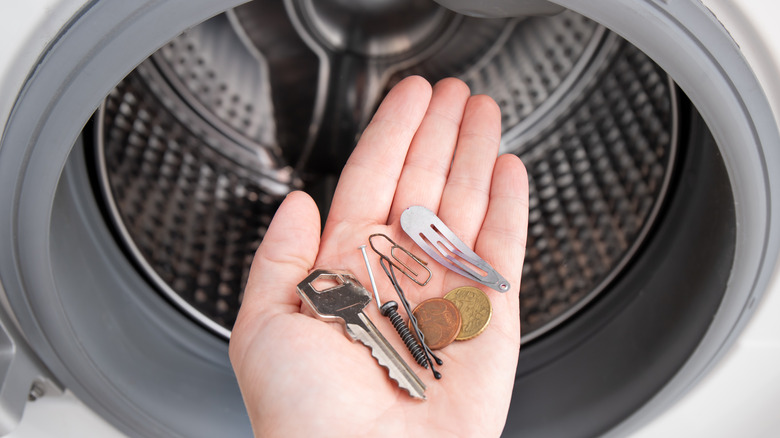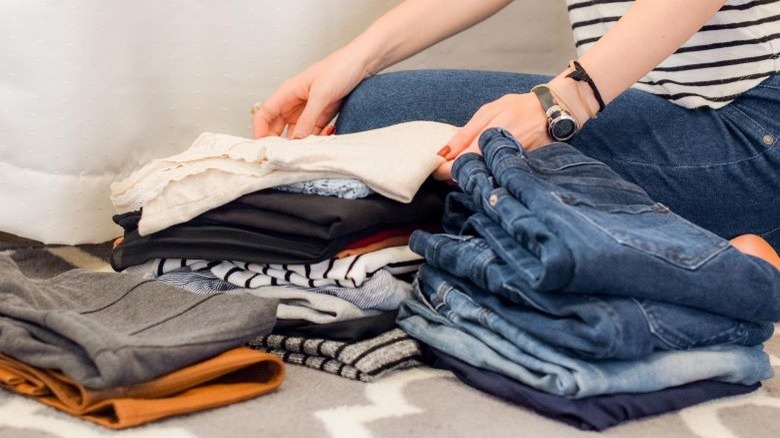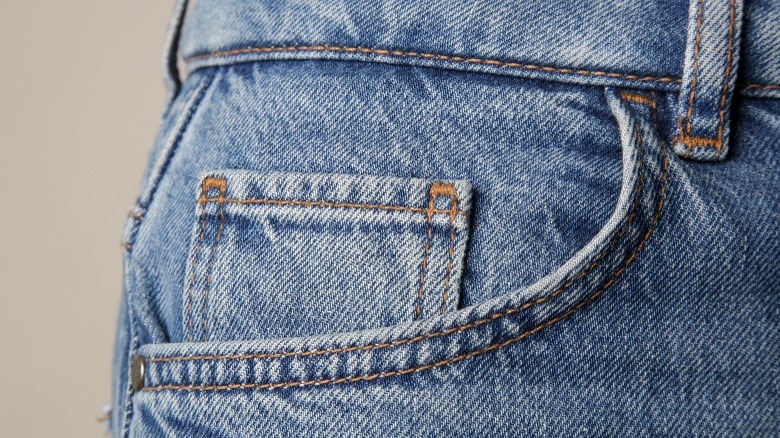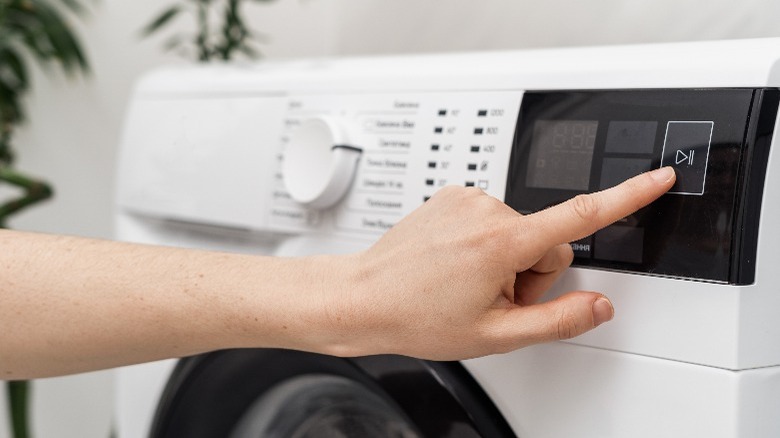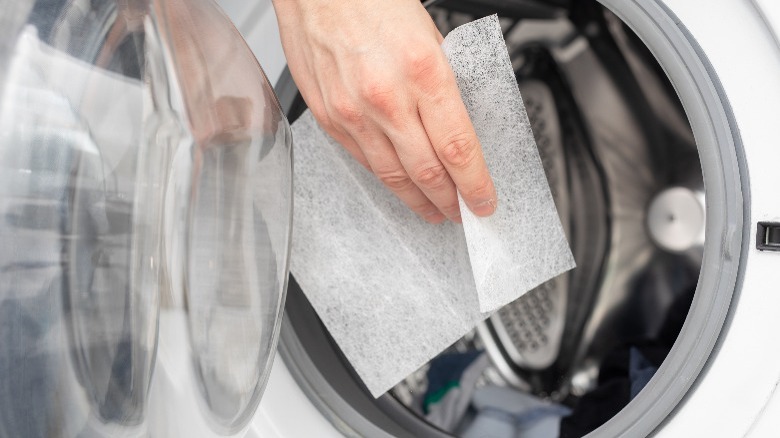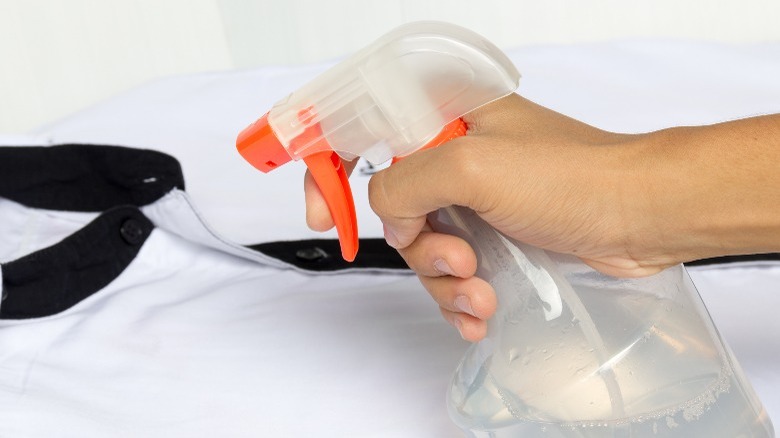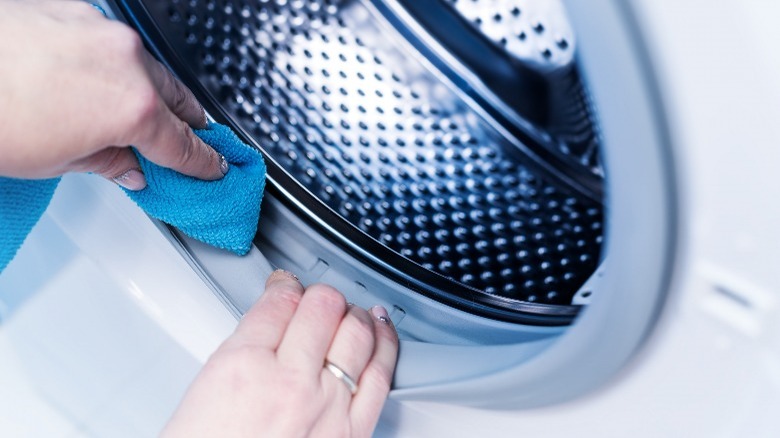What Everyone Gets Wrong When Doing Laundry
Laundry is often seen as a dreaded task since it's so easy to make mistakes that ruin clothes. But anyone who's been fumbling with their laundry can relearn the process and get better results.
The mistakes can be related to the prep work, like separating items incorrectly or making removable stains permanent. There are other ways to damage clothes, too, from forgetting to check pockets to not understanding how the different washer and dryer settings work. Undoubtedly, doing things the right way involves more effort, but these habits are worth learning and incorporating into your laundry routine. They will save time and money in the long run, since clothes won't need to be replaced as often, and things won't have to be rewashed and redried again and again. Read on for a well-rounded laundry lesson — here are some of the most common laundry mistakes and how to fix them.
Sorting only by color
The first rule of doing laundry is to sort clothes by color, which is especially important when things are being washed for the first time. Anyone who's had a white shirt turn pink in the washer can relate to that — always do whites in separate loads. But that is not the only way that laundry should be sorted.
Heavy and bulky things like towels shouldn't be washed or dried with light things like baby clothes or camisoles, either. Different weights require different settings with higher or lower water temperatures and speeds. Using the wrong ones can cause damage. They will also not dry evenly when in the same load. Finally, keep heavily soiled clothing and linens from other laundry items to prevent potential bacteria from spreading. In addition to that, heavily soiled items will need to be washed with harsher settings than normal clothes; you don't want to put your delicates under unneeded stress. If there's enough space in the laundry room, try to have four hampers: one each for whites, brights, bulky things, and super-soiled.
Dumping in too much detergent
Oversized jugs of laundry detergent can save money, but since they contain so much product, people tend to dump extra into the dispensers. They either forget to follow the recommended fill lines on the measuring cups or add more because they think it provides more cleaning power.
Using more detergent, even on super-soiled items, is a wrong move. Detergent is highly concentrated, so a small amount is more than enough to tackle the load's dirt and grime. And if you use too much, the machine won't be able to rinse it all off, leaving a residue on your washed clothes. This problem can be compounded when the home has hard water that leaves mineral residue on clothing. Excess detergent residue can also fade clothing, stiffen fabrics, and make them feel itchy. As for laundry pods, larger loads may require more than one — read the product label for instructions.
Overloading the machines
When a running washing machine suddenly starts thumping and shaking, it probably has too much laundry inside. The items get soaked and gather on one side, causing a loud back-and-forth motion that could damage the machine. Other overloading symptoms include the items coming out dirty and damp clothes at the end of dryer cycles. Trying to save time by laundering too many things at once usually has the opposite effect, since the cycles must be repeated. Doing this frequently could also damage the appliances and drive up energy costs.
Advertised washers and dryers prominently display their capacities, and this information can also be found online. Manufacturers specify how many pounds of laundry these appliances can handle, but most people don't weigh things before putting them in. Don't worry about the capacities and pounds because there is one easy rule: Never fill a washing machine or dryer more than three-quarters full. The laundry shouldn't be pressing against a front-loading washer door, higher than a top-loader agitator, or too close to a dryer's door.
Using the wrong stain treatments
Kudos to everyone who recognizes the importance of checking laundry for stains before putting them into the washer. Yet this is only part of the effort needed to remove those unsightly marks. Fabric stains can be made up of anything from ink to blood to grease and can't all be treated similarly. Store-bought stain removal products are often enough to do the job, but DIY removers can work even better. With any type of stain, early treatment offers the best chance of success. Blot away the excess and work on the residue while it's still damp. But avoid rubbing stains because that pushes them deeper into the fabric.
Stain removal guides help determine which methods are appropriate for certain offenders, but here are a few recommendations. Soak fresh blood stains in cold water and launder as usual; dried ones can be treated with stain removal products that have enzymes. Ink marks can be removed with rubbing alcohol, and wine stains must be soaked in cool water for half an hour before applying a prewash stain remover. Sweat stains can be tricky, but rubbing a bar of soap onto them before laundering is recommended.
Drying stains into fabrics
Stains can also set into fabrics through heat, so putting something into the dryer when the mark isn't completely removed is another common laundry oversight. It's exasperating to rediscover a stain on a dried shirt after having gone to the trouble of trying to remove it. And once it's dried, the chances of removing it plummet.
It's hard to know when a stain has been fully removed since the items will be wet after being taken out of the washing machine. Even when the most highly-trained eyes carefully examine a piece, mistakes are made. Stay on the safe side and air dry these pieces out of the sun and heat. Then, use the dryer's air cycle to soften the material and have a final look. If the stain can still be seen, repeat the removal process. This might need to happen a few more times, but if the efforts aren't successful, the item can be tossed or recycled.
Leaving zippers open
Zippers might look sturdy, but they must be treated carefully when laundering. Those sharp metal or plastic teeth are in place to work together in alignment, and when left open, they can scratch the insides of the machines and snag clothing. In addition, when a zipper is all the way down or partway closed, it is unprotected, making it vulnerable. Its exposed components do not hold up well to heat and the constant friction in the machines. Those working parts could melt, bend, or break off.
Remember to zip up everything that goes into the washing machine and dryer, pushing down the tabs on top to secure the closures. If a zipper doesn't seem to close up well enough, use a sturdy safety pin for the job. Anything with hooks, like bras, should be connected to prevent damaging them, other clothes, and appliances. Those can also be placed in mesh bags.
Buttoning up the buttons
After being instructed to close zippers before laundering, being told to unbutton buttons seems counterintuitive. But people also get this wrong, and here's why. Buttons are attached with thread, so the connection to the fabric is more fragile. It isn't as stressed when the thread isn't stretched to secure the button closed. Be extra careful with long-sleeved shirts since many have extra buttons on the collars and cuffs — those often get buttoned up and forgotten about. Riveted-on buttons like the ones on jeans are the exception to this rule because there's no thread, so those can be left buttoned.
Be sure to check threaded buttons for tightness because loose ones are vulnerable to falling off – in or out of the laundry. It's always a good idea to learn basic sewing skills and to have a small sewing kit in the laundry room for this very reason.
Not checking the pockets
Anyone who's ever been dismayed to see shredded-up tissue all over wet laundry will berate themselves for not checking the pockets before putting the clothes in the washer. Yet this is just a minor issue compared to other damage that can happen. A pocketed receipt could get soaked, lip balm could melt, and a cell phone could be destroyed. Something with a sharp edge, like a utility knife, could tear clothes and slice a hand.
But that's not all, because forgotten things in pockets can also damage washers and dryers. A set of keys could get loose and scratch the washer drum and outer tub, so if you hear that telltale clinking, turn off the appliance and take them out. Tissues, dollar bills, and gum present other problems because they can get into washing machine drains. From there, they can make their way into other parts of the appliance, which might need to be repaired.
Folding too soon
Laundry should be dry after coming out of a dryer, but this isn't always the case. And when people are in a hurry, they pull it out and start folding away. While pulling out damp things and hanging them up is fine, folks get it wrong when they fold instead. They figure everything will dry, but the dampness causes problems. Without air circulation, mold will form in the darker, hidden areas, and a musty odor will develop. Imagine pulling out folded sheets to make the bed and smelling something rank — that's not ideal.
The slightest bit of dampness can cause mold formation, and when left unattended, it could easily spread to nearby items. The same thing can happen when wet laundry is left in a washer. If you forgot it overnight, redo the load. Wet laundry left sitting for more than eight hours might contain bacteria as well as mold, so it will need to be rewashed.
Putting clothes in the dryer that should be air dried
Anyone who thinks all laundry can go in the dryer is wrong, but knowing what can and can't might be confusing. Bed linens, towels, cotton, and polyester can handle the heat, but other materials are too delicate. Never put silk or lingerie in a dryer because they will likely wrinkle up, tear, or shrink. Keep bathing suits out of there too, as well as clothing made with spandex. Clothing with glued-on beads or sequins won't come out looking the same either since heat dissolves the glue. Some wool garments are dryer-safe, but this is risky, so it's safer to lay them flat to dry. Also, avoid heat drying anything that is leather, suede, or fake leather.
Lingerie, swimsuits, and wool can be put on a short air-dry cycle after they've been hung out or laid flat and are dry to the touch. A quick fluff will make them soft again, but double-check that the correct setting is being used and only give it about 10 minutes.
Not giving jeans some TLC
A well-cut pair of tight jeans can be flattering, but ones that are shrunk down too small or discolored won't be wearable. Taking a few extra steps when laundering will keep them looking newer for longer. When a pair is ready for washing, turn them inside out to protect the seams from turning a whitish color. It's best to wash jeans together without other clothing since they tend to be heavier and more likely to bleed — select a cold, gentle cycle and use a mild detergent.
Speaking of bleeding, brand-new jeans are even more prone to this, but there's a helpful strategy. Before wearing them, rub white paper against the fabric. If colored residue shows up, the dye needs to be set, or it will get on everything. To do so, turn them inside out and soak them in 1 gallon of cold water with 1 cup of white vinegar. Give it at least an hour, remove the jeans, and wash them as described above. It's common practice to put jeans in dryers, but that causes fading over time. Even though the heavier material takes longer to air dry, that is the best method.
Using the wrong settings
Modern, high-tech washers and dryers should make people's lives easier, but sometimes the advanced settings can be confusing. Some prefer to read manuals while others learn by doing. Washing machines have three main setting categories: load size, water temperature, and speed. The wrong load size will use the wrong amount of water, and too much hot water and fast speeds can damage clothes.
A large load setting can be chosen when the washer is more than halfway full. Only use hot water for heavily soiled items and cotton fabrics. Cold water is good for delicates and darks; warm is appropriate for synthetics like polyester. Pick cycles with lower speeds for delicate items and faster ones for heavier ones like blankets. Rinse/spin and steam cycles are good for freshening things up.
Dryers have similar settings that can also be confusing. Aside from air dry, there is usually a gentle, permanent press, and regular setting. Use the gentle cycle on things like activewear or silk, and permanent press on things like colorful clothing and synthetic materials. Most dryers also have timed settings for users to input their preferences. Get into the habit of checking the settings each time a load is started and adjusting them as needed.
Wasting money on store-bought dryer sheets
Dryer sheets are convenient, but the cost adds up. They're made from cellulose or polyester fibers covered with liquid fabric softeners. Most have pleasant fragrances, which is a big selling point. However, people who don't like buying them can still get soft, nice-smelling laundry with DIY versions. To make a batch, use 15 to 20 clean washcloths or cut-up towels. Put them in a sealable, quart-sized container with a tight-fitting lid like a mason jar. Add ½ cup of water to a pot, boil it, and allow it to cool. Pour that into the jar with 1-½ cups of white vinegar and drops of essential oil. Seal, shake, and use as needed. These can be used repeatedly and cost next to nothing.
These work because vinegar fights static and softens fabric without any harsh chemicals. And don't worry about the smell because the essential oil takes care of that. It won't be noticeable when the laundry is finished.
Wasting money on store-bought wrinkle spray
Wrinkle spray releasers are another time-saving laundry product that can make ironing clothes unnecessary. Instead of going back and forth with a hot iron, consumers can hang the clothing up, spritz, tug out the wrinkles, and let it dry. Bounce's 3 in 1 version costs about $12 for 9 ounces, but as one can imagine, these products can get used up pretty quickly. Ones that claim to be eco-friendly might have even higher price points.
A homemade wrinkle spray releaser also uses vinegar plus a secret ingredient — hair conditioner. To whip some up, add 1 tablespoon of the former and 1 teaspoon of the latter into a clean spray bottle and pour in 1-¾ cups of warm water. Shake well and use it just like a brand-name product. Spray the fabric about 8 inches away in a quick sweeping motion until it's damp. Then tug on the material until the wrinkles release.
Never cleaning washers and dryers
Even though washers work with detergent and clean clothes go into dryers, these appliances still need to be cleaned occasionally. Buildup from detergent, softeners, and other residues clogs washing machines and stinks up the insides. For regular cleaning, run a hot cycle with ½ a cup of vinegar and no detergent. Swap the vinegar out for ¼ cup of bleach if the machine is extra dirty. Wipe down the inside with vinegar/water spray and microfiber cloths.
Cleaning a dryer's lint trap will prevent clogs, but to clean the interior, start by unplugging the machine. For electric dryers, clean the inside with dish soap and warm water; use a non-flammable household cleaner for gas ones, and then wipe it with a damp towel. This is a good time to clean the dryer vent, since clogged ones reduce efficiency and can become fire hazards. Pull the dryer away from the wall and disconnect the connecting tape or clamps. The vent can be cleaned with a vacuum hose attachment. Before reattaching it, clean the exterior vent outside the house. And once everything's put back together, run an empty cycle for 15 minutes to remove any residual dust.

